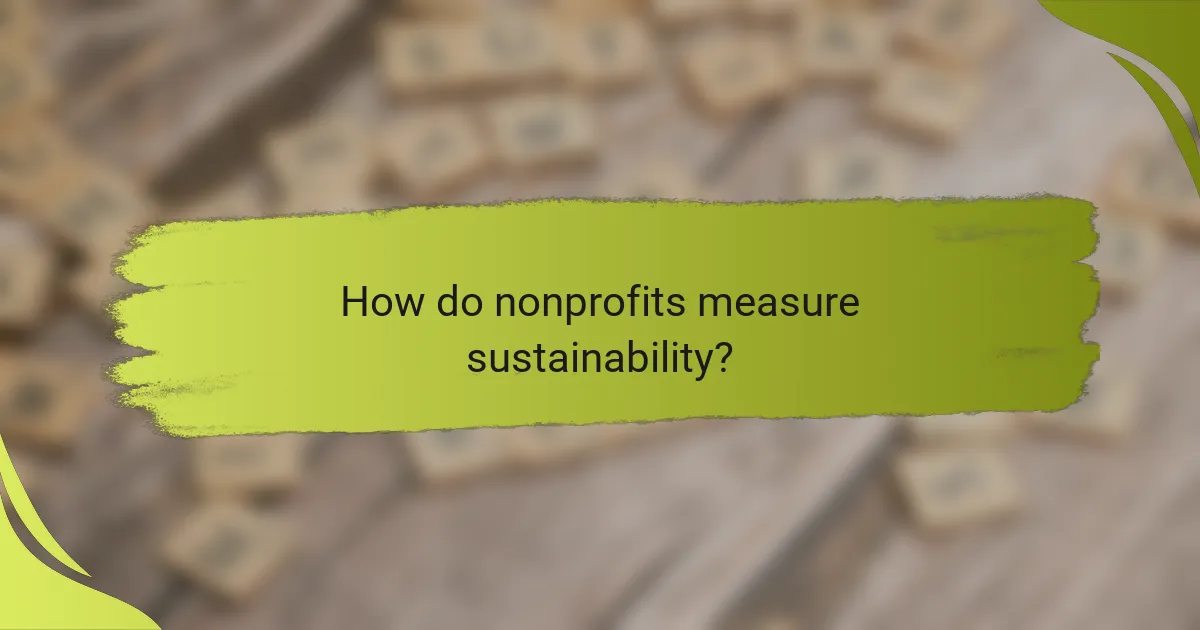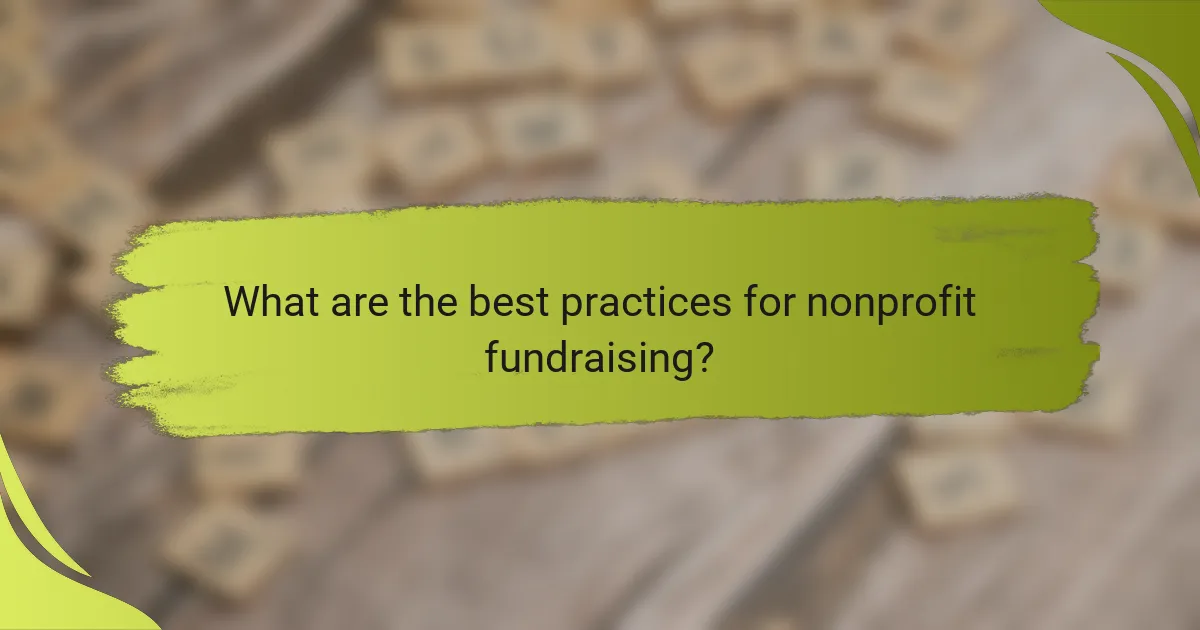Cost considerations are crucial for nonprofits aiming to enhance their sustainability and impact. By leveraging grants, forming strategic partnerships, and utilizing volunteers, organizations can significantly reduce operational costs while maximizing outreach. Additionally, effective budgeting and the use of technology can further optimize resource management, ensuring long-term viability and efficiency.

What are the cost-effective strategies for nonprofits in the US?
Cost-effective strategies for nonprofits in the US include leveraging grants, forming partnerships, utilizing volunteers, and implementing digital fundraising campaigns. These approaches can significantly reduce operational costs while maximizing outreach and impact.
Grant writing for funding
Grant writing is a crucial strategy for nonprofits seeking funding. By crafting compelling proposals that align with the priorities of grant-making organizations, nonprofits can secure financial support for their programs and initiatives.
To enhance success, focus on clear objectives, measurable outcomes, and a well-defined budget. Research potential funders thoroughly to ensure alignment with your mission and goals.
Partnerships with local businesses
Forming partnerships with local businesses can provide nonprofits with resources and funding opportunities. These collaborations can involve sponsorships, in-kind donations, or joint events that benefit both parties.
Consider approaching businesses that share similar values or community goals. A mutually beneficial partnership can enhance visibility and create a stronger community impact.
Utilizing volunteer resources
Volunteers are a vital resource for nonprofits, offering skills and time without the associated costs of paid staff. Engaging volunteers effectively can help reduce operational expenses while expanding program reach.
To maximize volunteer contributions, provide clear roles, training, and recognition. Create a positive environment that encourages retention and fosters a sense of community among volunteers.
Implementing digital fundraising campaigns
Digital fundraising campaigns are an effective way for nonprofits to reach a wider audience and generate donations. Utilizing social media, email marketing, and crowdfunding platforms can significantly lower fundraising costs.
When planning a digital campaign, set clear goals, create engaging content, and utilize analytics to track performance. Consider using storytelling techniques to connect emotionally with potential donors and encourage contributions.

How can nonprofits manage operational costs?
Nonprofits can effectively manage operational costs by implementing strategic budgeting, utilizing shared services, and leveraging technology. These approaches help organizations maximize their resources while maintaining sustainability and efficiency.
Budgeting and financial planning
Effective budgeting and financial planning are crucial for nonprofits to control operational costs. Organizations should create detailed budgets that outline expected income and expenses, allowing them to allocate resources wisely. Regularly reviewing and adjusting these budgets can help identify areas for cost savings.
Consider using a zero-based budgeting approach, where every expense must be justified for each new period. This method can uncover unnecessary expenditures and encourage more thoughtful spending.
Reducing overhead through shared services
Nonprofits can significantly reduce overhead costs by sharing services with other organizations. This collaboration can include joint purchasing agreements, shared administrative functions, or co-locating facilities. By pooling resources, nonprofits can achieve economies of scale and lower individual costs.
For example, two nonprofits might share a marketing team or office space, which can lead to substantial savings on salaries and rent. Establishing clear agreements and communication channels is essential to ensure that shared services run smoothly.
Leveraging technology for efficiency
Integrating technology can enhance operational efficiency and reduce costs for nonprofits. Tools such as cloud-based software for project management, donor management systems, and automated financial reporting can streamline processes and save time. Investing in the right technology can lead to long-term savings.
Nonprofits should evaluate their current technology needs and consider adopting solutions that fit their budget. Many software providers offer discounted rates or grants for nonprofits, making it easier to access essential tools without overspending.

What resources are available for nonprofit sustainability?
Nonprofits can access various resources to enhance their sustainability, including government grants, nonprofit resource centers, and community foundations. These resources provide financial support, guidance, and networking opportunities essential for long-term viability.
Accessing government grants
Government grants are a significant resource for nonprofits seeking funding for specific projects or operational costs. These grants often target particular areas such as education, health, or community development, and can range from a few thousand to several million dollars.
To access these funds, nonprofits must typically submit detailed proposals outlining their mission, project goals, and budget. It’s crucial to adhere to application deadlines and guidelines to increase the chances of receiving funding.
Utilizing nonprofit resource centers
Nonprofit resource centers offer a wealth of information and support services tailored to the needs of nonprofits. These centers often provide training, workshops, and consulting services that help organizations improve their operational efficiency and fundraising strategies.
Many resource centers also maintain databases of funding opportunities and can assist with grant writing. Engaging with these centers can help nonprofits stay informed about best practices and emerging trends in the sector.
Engaging with community foundations
Community foundations are local philanthropic organizations that manage funds to support various causes within their communities. By partnering with these foundations, nonprofits can access grants, donor networks, and capacity-building resources.
Nonprofits should consider building relationships with community foundations by attending local events and participating in collaborative initiatives. This engagement can lead to increased visibility and potential funding opportunities tailored to local needs.

How do nonprofits measure sustainability?
Nonprofits measure sustainability through various methods that assess their long-term viability and impact. Key approaches include tracking performance indicators, conducting impact assessments, and evaluating resource management practices.
Key performance indicators (KPIs)
KPIs are quantifiable metrics that nonprofits use to gauge their sustainability efforts. Common KPIs include financial health indicators, such as revenue growth and expense ratios, as well as social impact measures, like the number of beneficiaries served or community engagement levels.
To effectively use KPIs, nonprofits should establish clear goals and regularly monitor these indicators. For instance, a nonprofit might aim for a revenue increase of 10-15% annually while maintaining program expenses below 75% of total costs. This helps ensure financial stability while maximizing impact.
Impact assessments and evaluations
Impact assessments evaluate the effectiveness of a nonprofit’s programs and initiatives, providing insights into their sustainability. These assessments often involve collecting data on outcomes, beneficiary feedback, and alignment with organizational goals.
Nonprofits can conduct evaluations periodically, such as annually or biannually, to measure progress and adjust strategies accordingly. Utilizing frameworks like the Logic Model can help in structuring these assessments, ensuring that all aspects of sustainability are considered, from resource allocation to community impact.

What are the best practices for nonprofit fundraising?
Effective nonprofit fundraising relies on building strong relationships with donors, creating engaging campaigns, and leveraging social media for outreach. These practices not only enhance financial support but also foster community engagement and long-term sustainability.
Developing donor relationships
Building donor relationships is crucial for sustainable fundraising. Start by identifying potential donors and understanding their interests and motivations. Regular communication, personalized messages, and expressing gratitude can strengthen these connections.
Consider implementing a donor management system to track interactions and preferences. This allows for tailored engagement strategies, ensuring that donors feel valued and appreciated, which can lead to increased giving over time.
Creating compelling fundraising campaigns
Compelling fundraising campaigns tell a story that resonates with potential donors. Clearly articulate your mission and the impact of their contributions. Use visuals and testimonials to create an emotional connection.
Set specific fundraising goals and timelines to create urgency. Offering clear incentives, such as matching gifts or recognition opportunities, can motivate donors to contribute. Regularly update supporters on campaign progress to maintain interest and engagement.
Utilizing social media for outreach
Social media is a powerful tool for reaching a wider audience and engaging with supporters. Create a content calendar that includes a mix of informative posts, success stories, and calls to action. Platforms like Facebook, Instagram, and Twitter can help amplify your message.
Encourage sharing and interaction by hosting online events or challenges. Use targeted ads to reach specific demographics, which can enhance visibility and attract new donors. Monitor engagement metrics to refine your strategy and improve future campaigns.

What are the challenges faced by nonprofits in the US?
Nonprofits in the US encounter several challenges that can impact their operations and sustainability. Key issues include competition for funding and navigating complex regulatory compliance requirements.
Competition for funding
Nonprofits often face intense competition for limited funding sources, which can include grants, donations, and sponsorships. Many organizations are vying for the same pool of resources, making it crucial for nonprofits to differentiate themselves and demonstrate their impact effectively.
To improve funding prospects, nonprofits should focus on building strong relationships with donors and stakeholders. This can involve creating compelling narratives about their mission and outcomes, as well as engaging in community outreach to raise awareness and support.
Regulatory compliance issues
Nonprofits must adhere to various federal, state, and local regulations, which can be complex and time-consuming. Compliance requirements may include maintaining tax-exempt status, filing annual reports, and following specific fundraising laws. Failure to comply can result in penalties or loss of funding.
To navigate these challenges, nonprofits should invest in training for staff and volunteers on compliance issues and consider consulting with legal or financial experts. Regular audits and reviews of compliance practices can help ensure adherence to regulations and mitigate risks associated with noncompliance.
